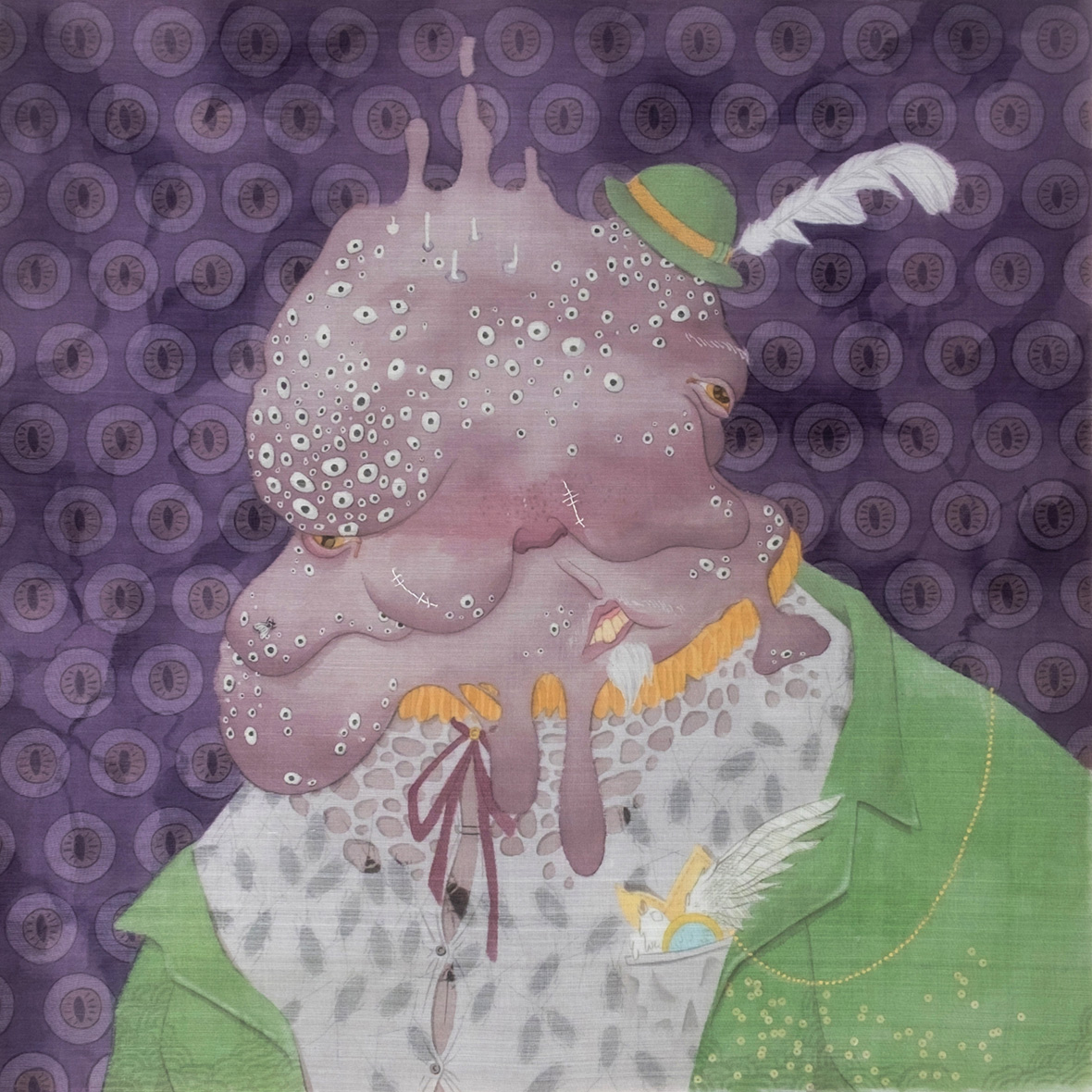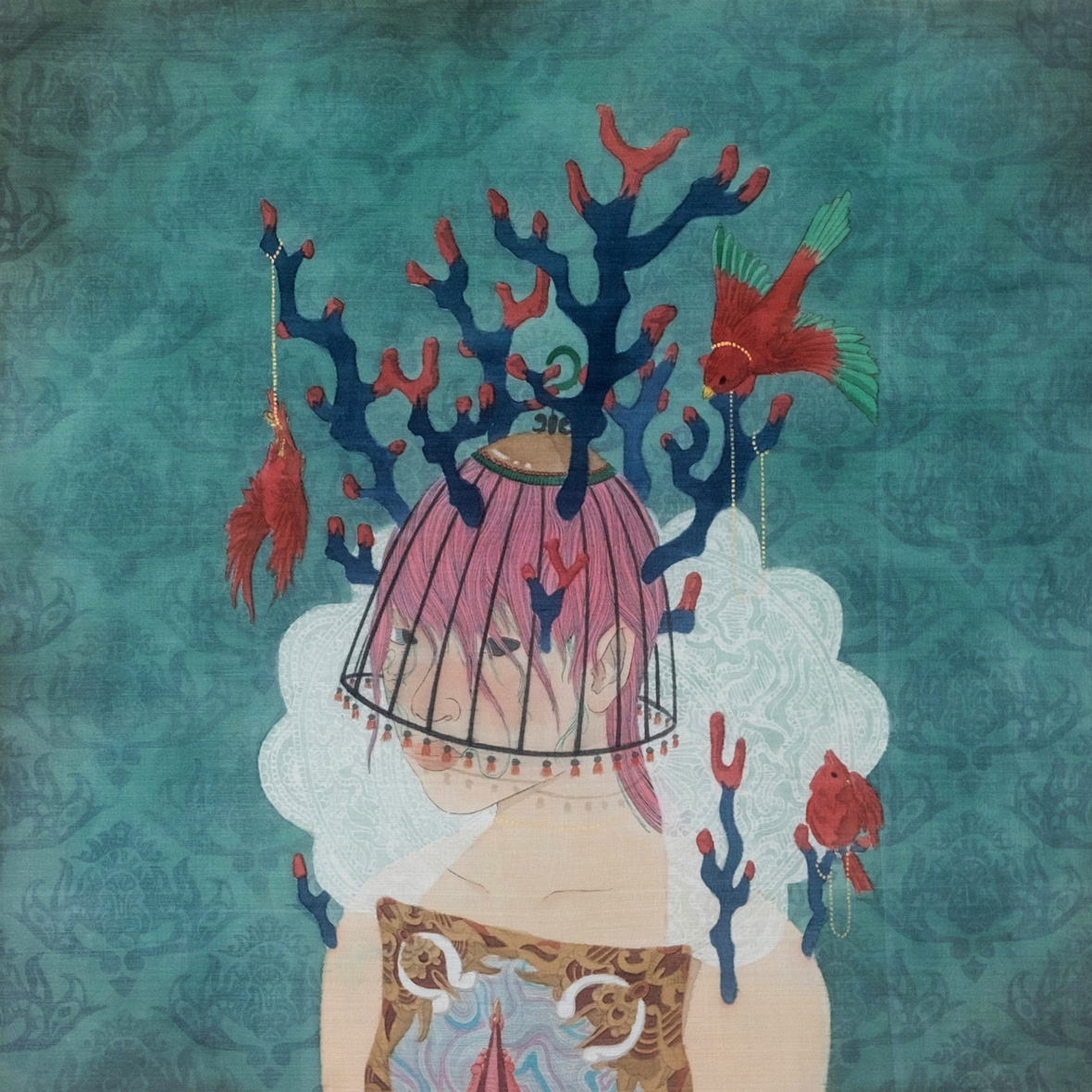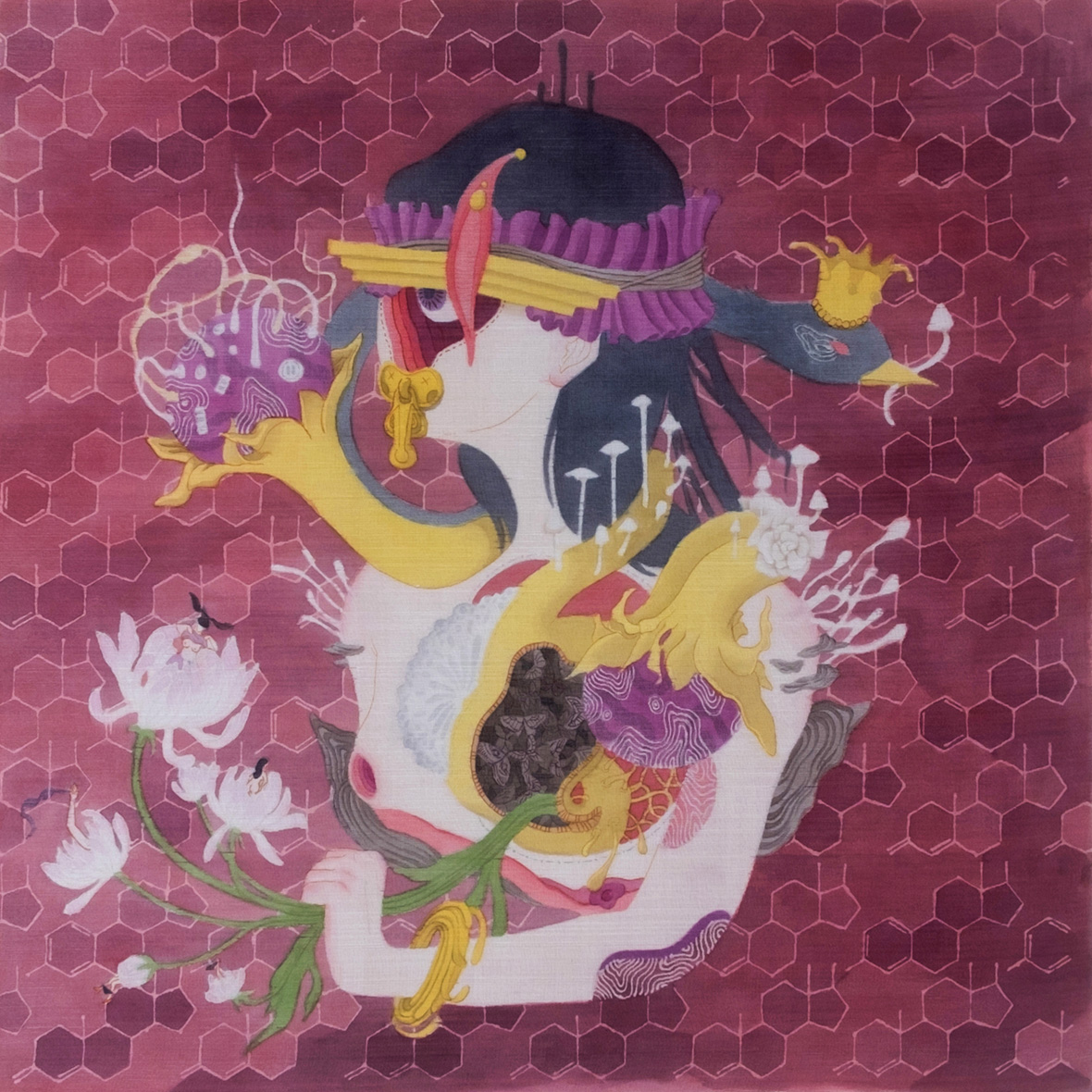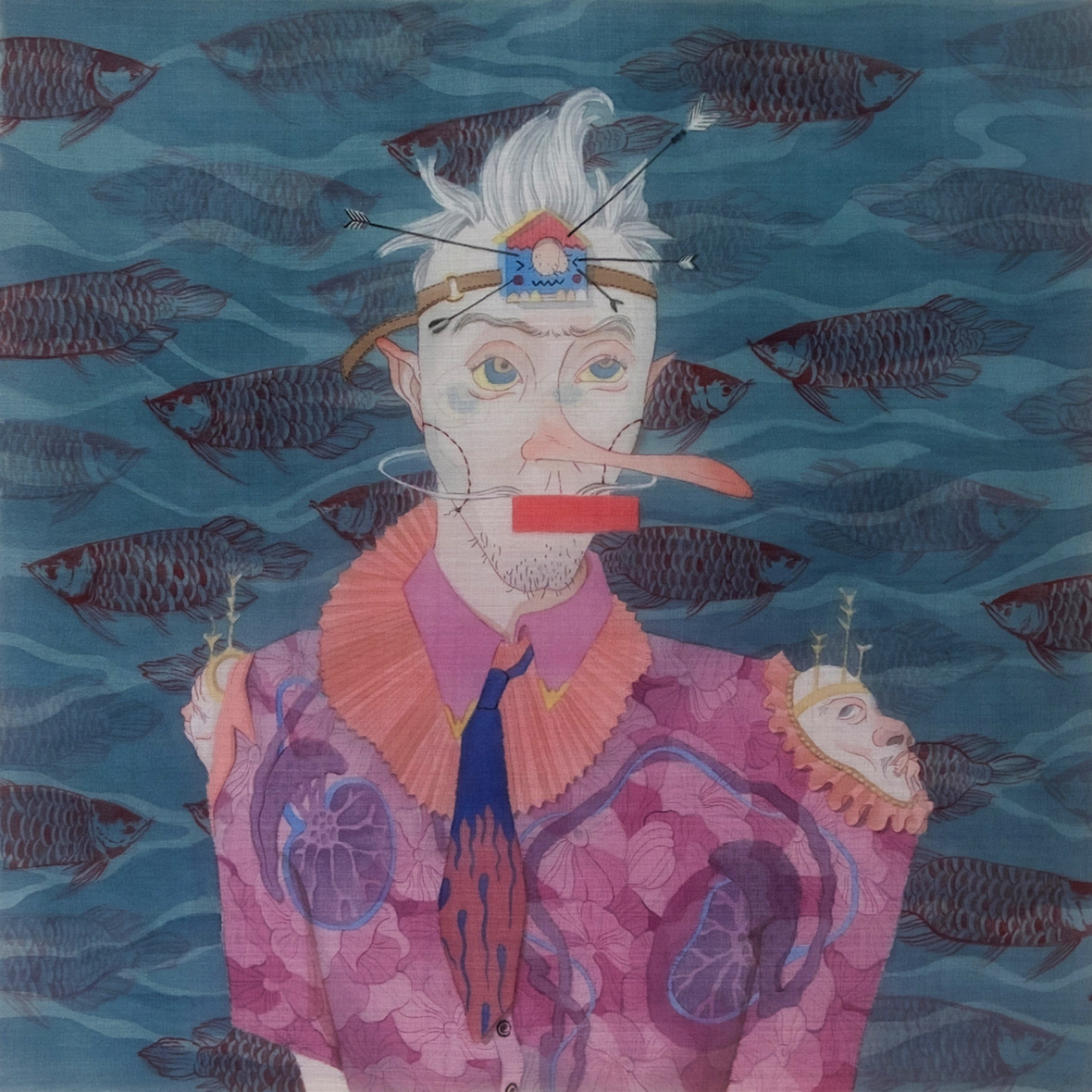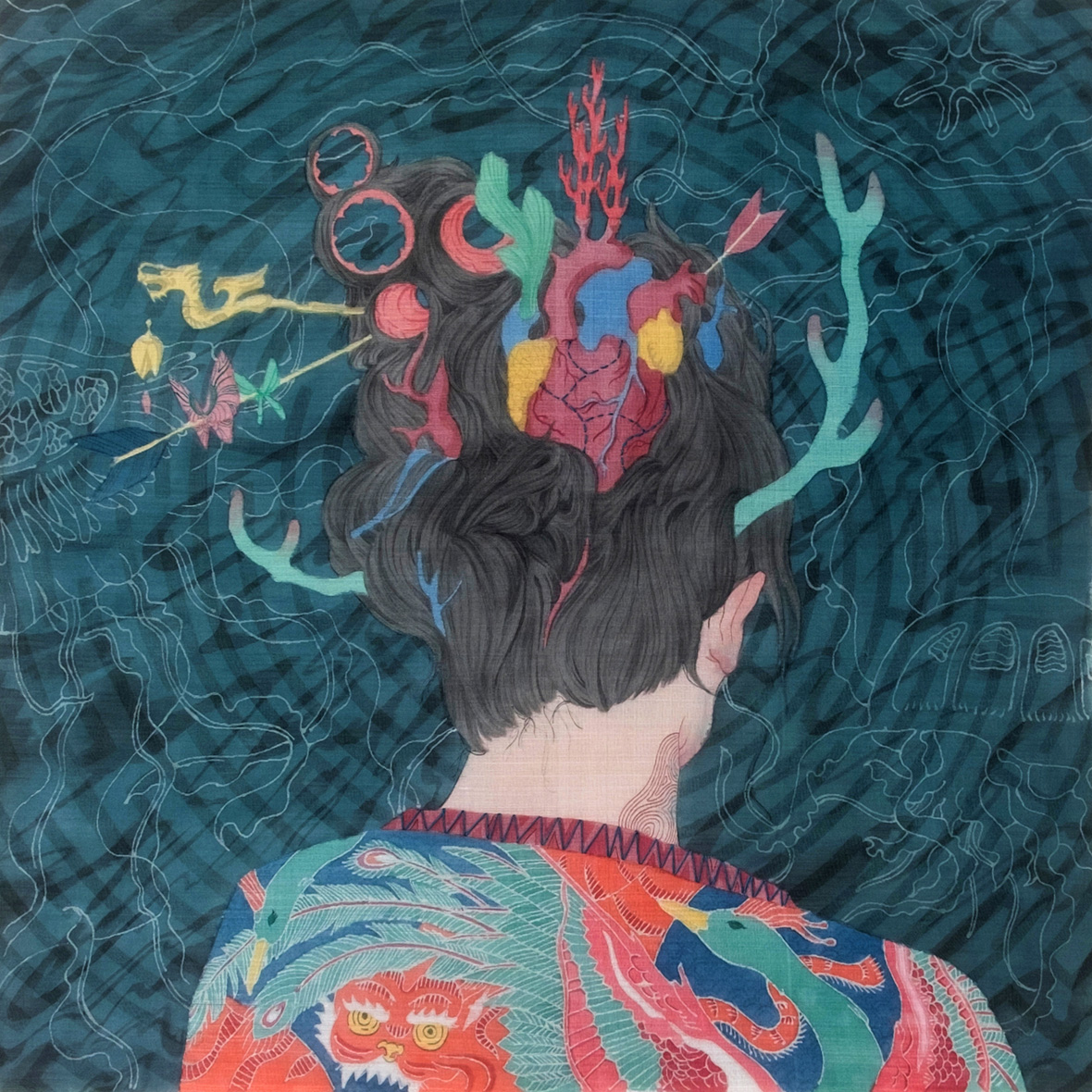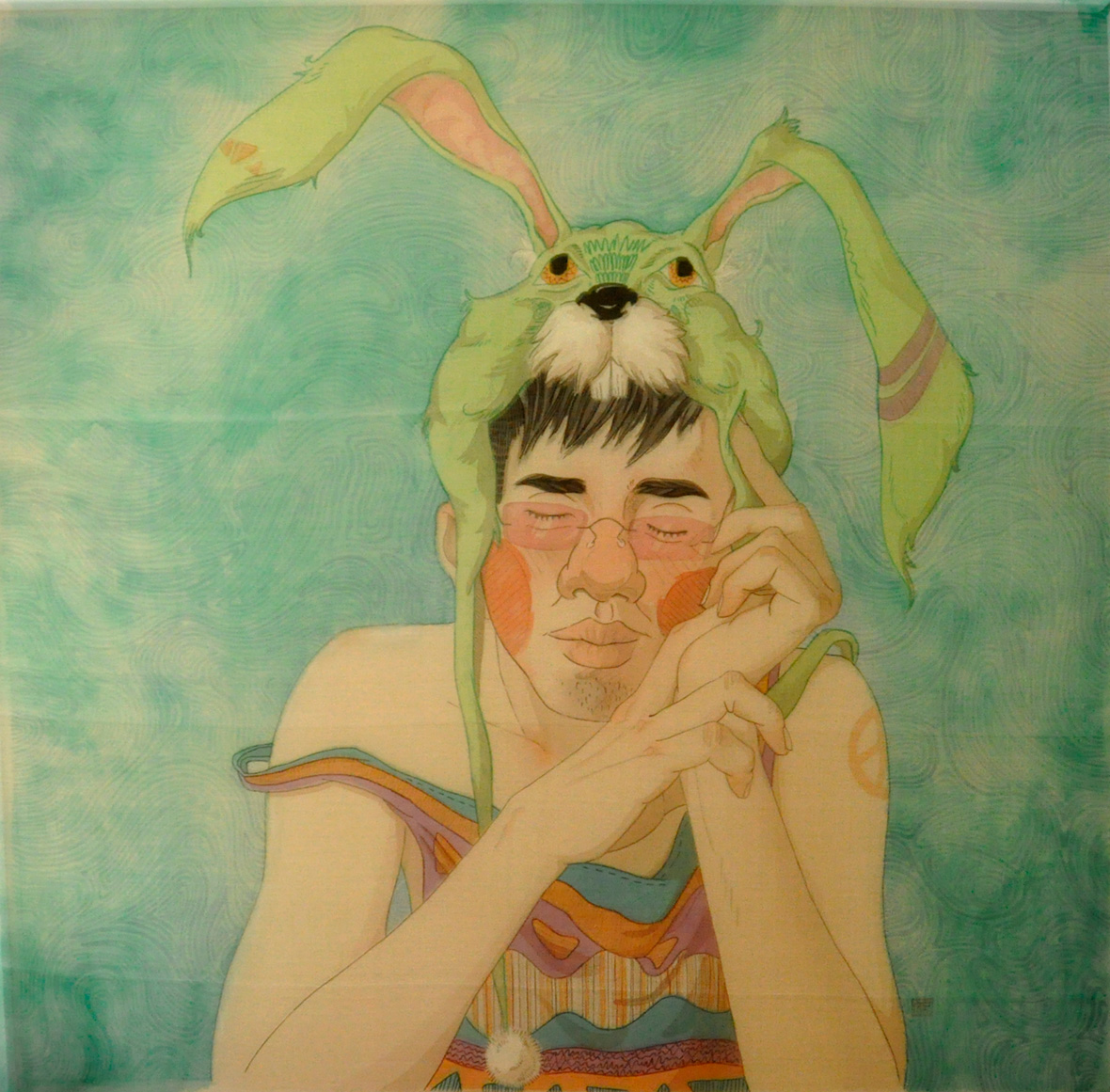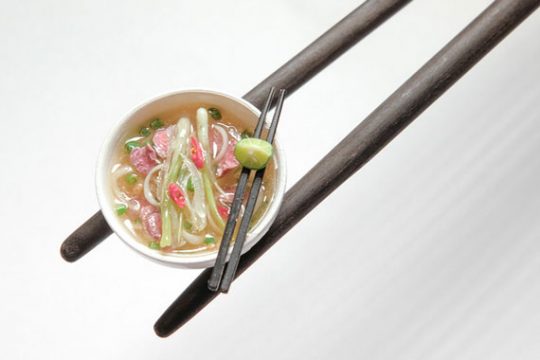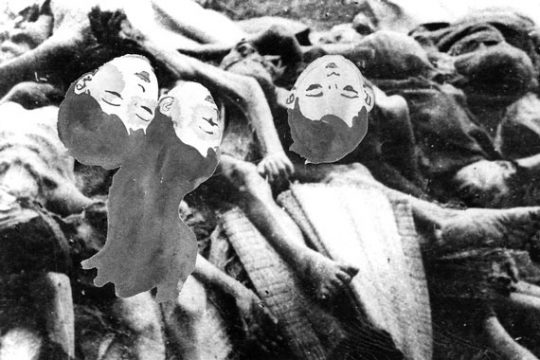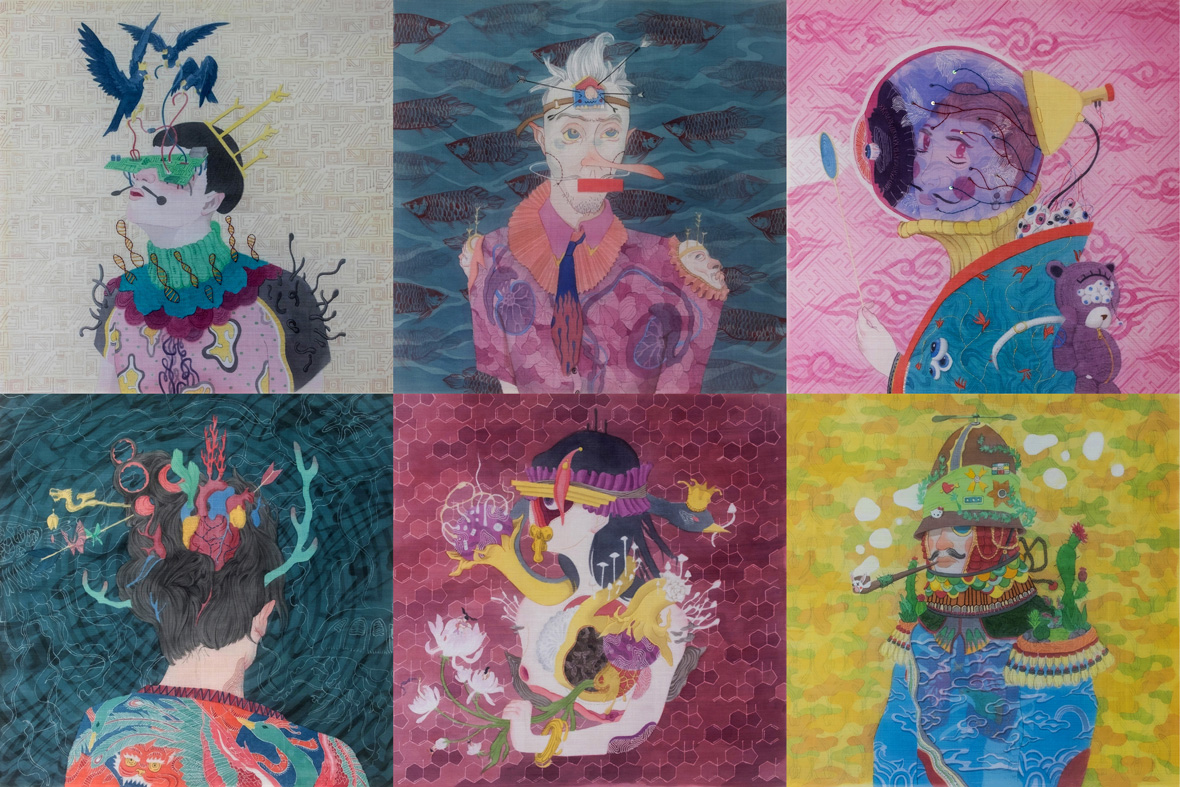
Inside Tinsideout’s silken dreamscapes, viewers are met by the colorful cast of chimeric creatures who inhabit his imagination. These character collages—from antler-sprouting humans to a melting lump of flesh—are mutant offsprings born from the artist’s interpretation of the collective unconscious, which, as proposed by Carl Jung, house knowledge of symbols and imagery that are universally recognizable.
“My practice is to use the portrait genre as a canvas to stretch ideas about identity,” he says. It is through the revelatory art of portraiture that Tinsideout—whose real name is Tran Nguyen Trung Tin—found his identity as a visual artist. The moniker Tinsideout is as much about self-expression as it is about his quest to illustrate the interior of the psyche.
在 Tinsideout 创作的绢画所筑造的梦境里,各种想象的奇妙生物幻化而生。从长出鹿角的人类到融化的肉堆,这些千奇百怪的角色脱胎于 Tinsideout 对“集体无意识”的理解。“集体无意识”这个概念即人类所普遍认同的符号和图像,由心理学家卡尔·荣格(Carl Jung)提出。
Tinsideout 说:“创作肖像画是我探索身份认同的一种方式。”原名为 Tran Nguyen Trung 的他,正是通过启发性的肖像画艺术,找到了自己作为视觉艺术家的身份。Tinsideout 这个名字既是一种自我身份表达,也代表着他对于大胆出柜、呈现真实自我的追求。
In college, Tran found himself captivated by the endless possibilities of silk early on. He graduated with a degree in silk painting before going to the UK for his master’s in art. Vietnamese silk painting—which flourished under French colonialism—combines the finessed watercolor techniques of Europe and its love for genre art with the country’s artistic traditions. Unlike silk painting traditions in China and feudal Japan, which used inks and colors made from soot or minerals and depicted the royal court or landscapes, Vietnamese silk paintings favor scenes from everyday life. Their poetic and languid qualities have been the subject of much praise.
读大学的时候,Tinsideout 开始热衷于探索丝绸的艺术创作可能性,并在毕业时获得了绢画艺术的学位。越南绢画在法国殖民时期蓬勃发展,出色融合了欧洲精美的水彩技艺、对风俗画艺术的热爱以及越南当地的艺术传统。在中国和封建时代的日本,传统绢画通常是使用烟灰或矿物制成的墨水和颜料描绘皇室或风景;而越南的传统绢画则偏爱描绘日常的生活场景,其诗情画意与慵懒惬意的风格一直备受赞誉。
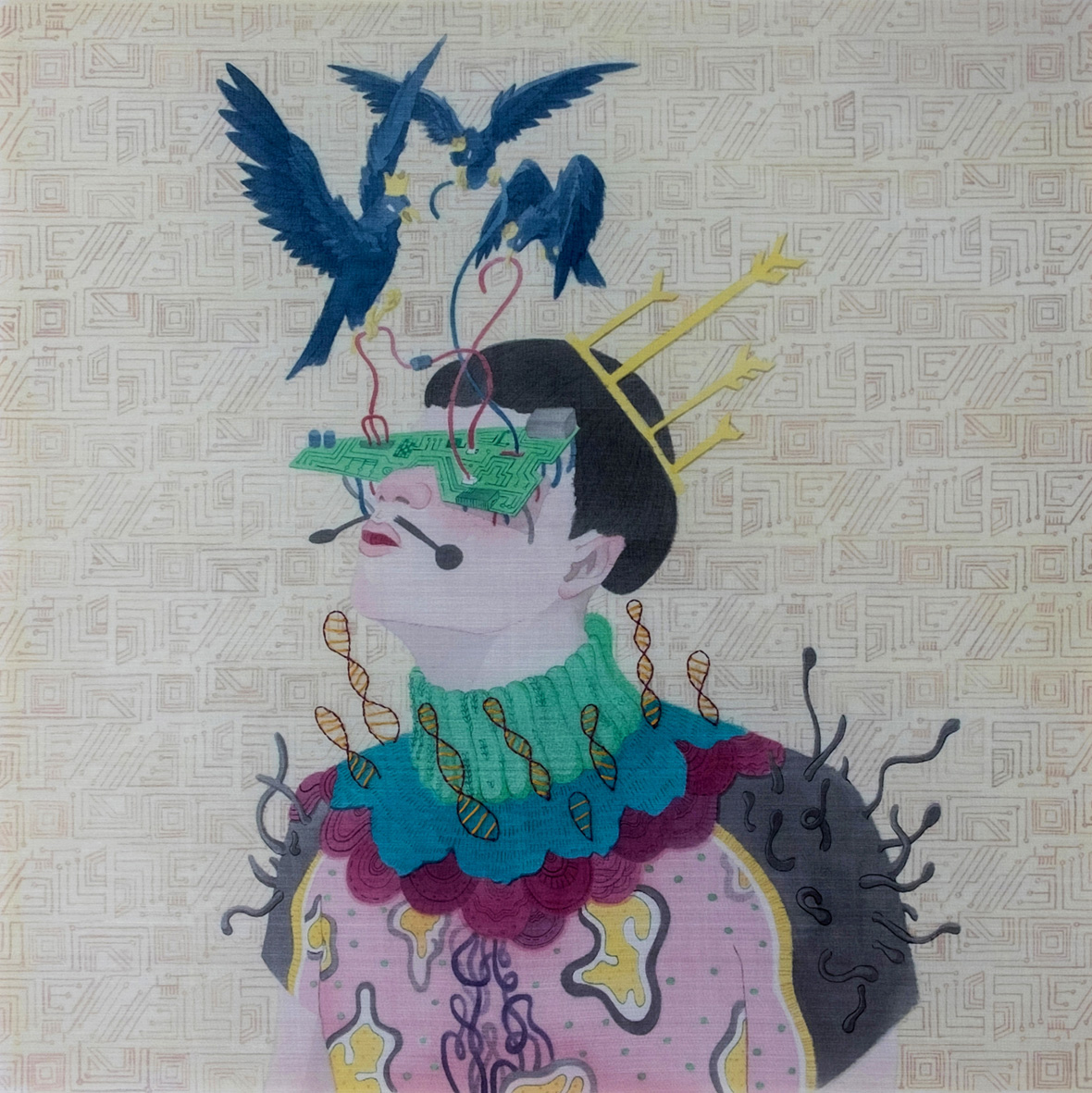
Just as brushstrokes build upon the previous ones to form something beautiful in traditional painting, silk painters build on tradition. Over the years, Tran has made his focal point the ethereal quality of organza silk, experimenting with how to push its limits. Instead of painting on one single layer before mounting it on paper, Tran paints on three and forgoes the paper backing. The result is his signature style of triple-layer silk paintings, first of their kind in terms of technique. Without the solid paper, the diaphanous layers take on a luminous sfumato quality, blurring the lines between the seen and the imagined.
正如绘画通过对过往经典的再度诠释一样,绢画艺术家也在传统的基础上进行改良。多年来,Tinsideout 一直着眼于透明硬纱丝绸的空灵风格,尝试创新突破。他没有选择在单层面料上绘画再贴于纸上,而是放弃纸背衬,选择在三层面料上绘画,最终形成他标志性的三层绢画作品,从工艺上来讲,这是史无前例的。没有了纸背衬,层叠的透明丝绸呈现出绚目的晕染效果,模糊了现实与想象之间的界线。
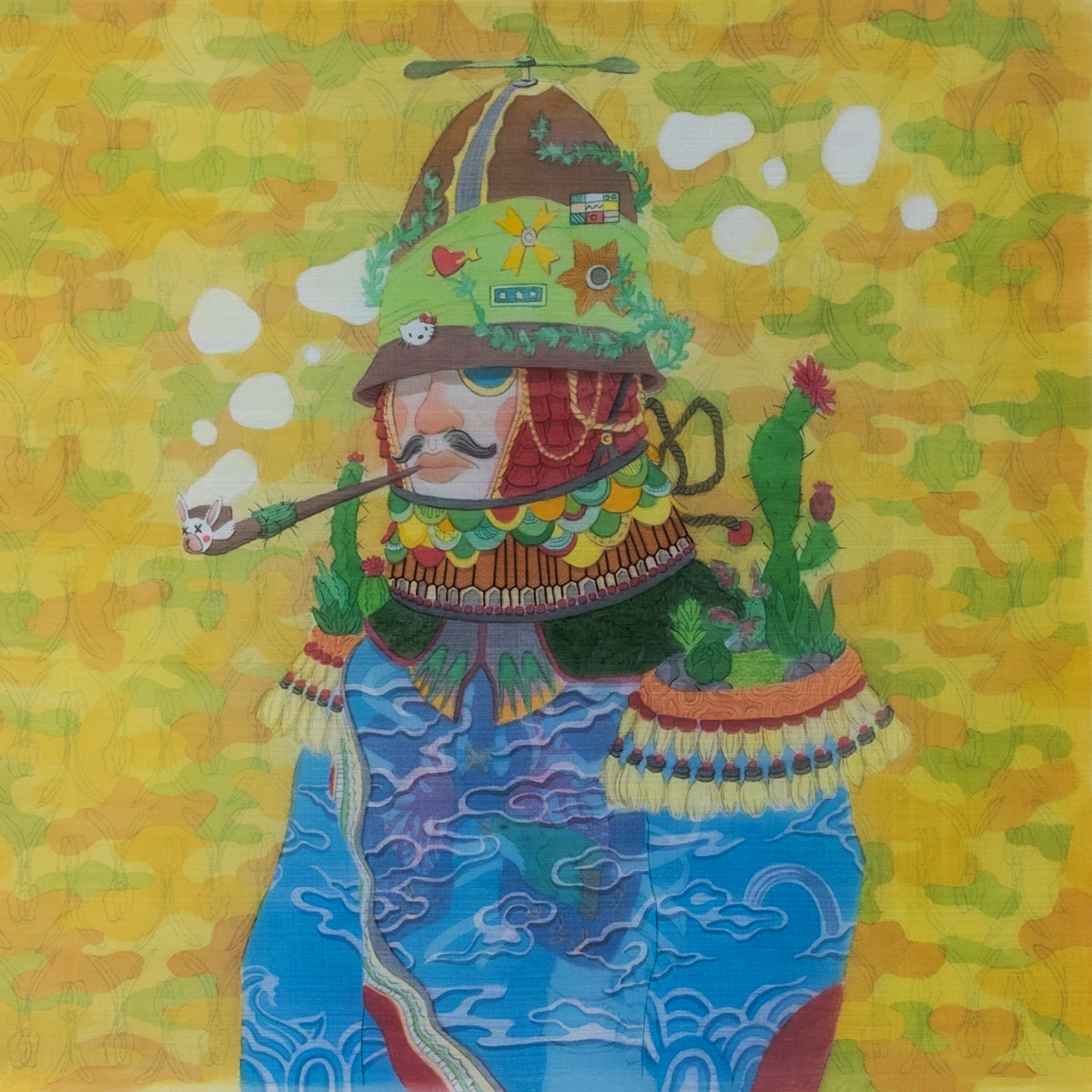
In Beauté-Faux, a collection of nine silk paintings, Tran reimagines body parts as nine interconnected fictional characters, of which The Brain is the central figure. Tran’s accompanying narrative mirrors the wretched passions of life: The Heart, a woman with her back turned, is the mother who constantly reminds The Brain of his origin. The Testicles, described as “vicious and passive-aggressive,” turns lust and longing into feelings of unworthiness. Though veiled by metaphors, Tran’s art is confessional, emoting a complex inner life that resonates universally.
在由 9 张绢画组成的《Beauté-Faux》系列中,Tinsideout 将身体的不同部位变成 9 个相互关联的虚构角色,其中“大脑”是中心人物。在随附的文案中,他描写了生活的一些不幸的情感:背过身的“心脏”扮演着母亲的角色,不断提醒着“大脑”的身世起源;“邪恶而被动攻击型”的“睾丸”将欲望和渴望变成卑劣的感觉。尽管他的艺术充满隐喻,却又是一种自白,揭示着每个人心中的复杂内心世界。
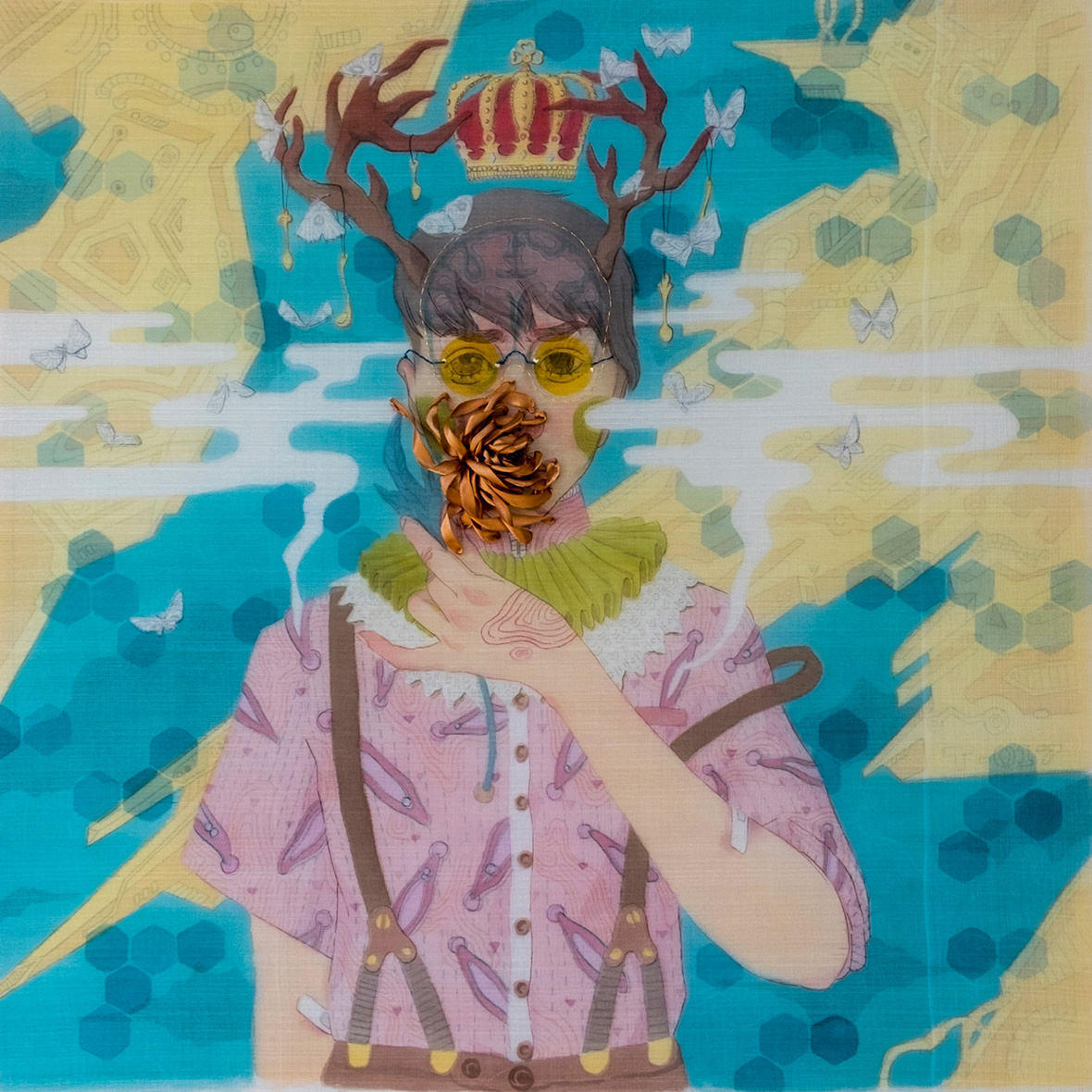
Together, the series is a self-portrait in nine parts. The imagery of Beauté-Faux delves into the surreal terrains of Tran’s imagination and shines a psychoanalytic light inwards. “This is an attempt to question and reconsider my own thoughts and memories, as the mind can sometimes make up unreal memories, so real that you actually thought they did happen,” he says.
Questioning his own past, Tran wrestles with whether or not his memory is a reliable narrator. To what extent is the haze of our memory tinted by yearning and emotions? Was it beautiful because we wanted it to be good?
These are the questions to which Tran hopes the process of making art may provide an answer. In turning himself inside out and placing his findings for all to view, he illustrates a complex and ever-fascinating subject: how our different inner selves affect our perception of the external world.
《Beauté-Faux》系列如同是九幅画组成的自画像,深入剖析了 Tinsideout 的虚幻想象,照亮其内心的世界。他说:“我希望通过这种方式,去质疑和重新思考我自己内心的想法和回忆,因为内心有时也会虚构出不真实的记忆,但这些记忆感觉如此真实,以致于你会以为它们真实发生过。”
Tinsideout 质疑着自己过往的记忆,为这些回忆的真实性而苦恼。我们的记忆在多大程度上受到渴望和情感的影响?回忆之所以美好,只是因为我们内心希望如此吗?他希望通过艺术创作找到这些问题的答案。因而,Tinsideout 剖析自己的内心,将想法袒露出来,在绢画作品中传达一个复杂而又引人入胜的主题:每个人内心所拥有的、不同的自我,以及它们如何影响我们对外部世界的认知。
Like our stories? Follow us on Facebook and Instagram.
Website: www.tinsideout.xyz
Instagram: @tinsideoutxyz
Contributor: Lace Nguyen
Chinese Translation: Olivia Li

